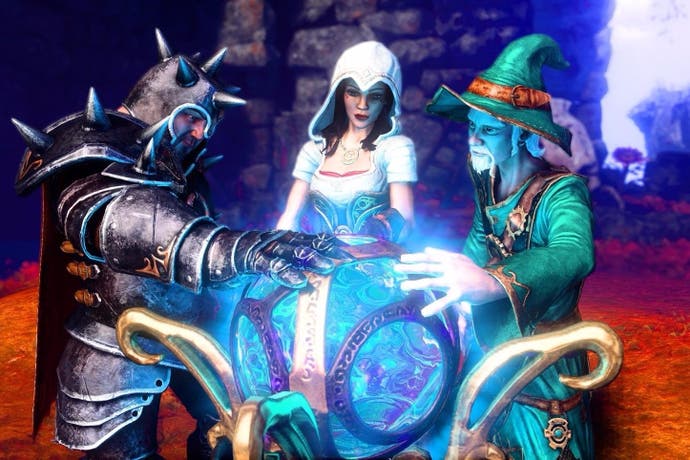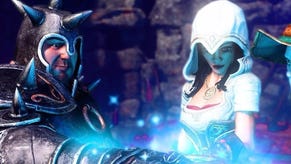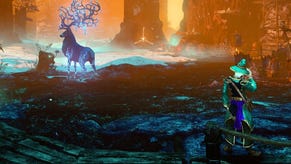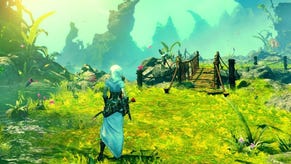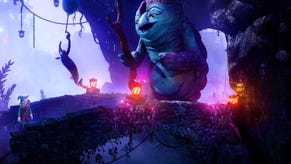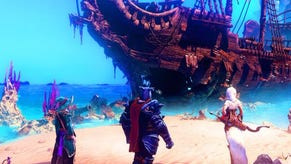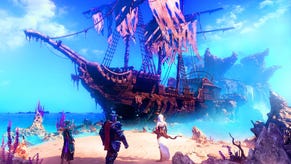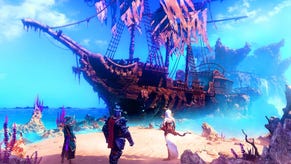Trine 3 review
Depth perceptions.
The Trine games have always been closet 3D titles. They might restrict the player to two axes of movement, but their rich fairytale landscapes act as visual plunge pools, twinkling with brilliance and irresistible in their depth. They tempt the eye to look past that single, flat plane, tantalising with hints of a much larger world. What secrets lie beyond that sun-dappled pumpkin patch, that verdant forest foliage, that crystalline tropical ocean?
With Trine 3, Frozenbyte has whispered the incantation to unlock that hitherto forbidden dimension, granting you permission to immerse yourself in its warm and inviting world like a night in the arms of a Fae. Unfortunately, Frozenbyte's venture into fully 3D platforming proves more fable than fairytale. The moral here is you should be careful what you wish for, because sometimes you just might get it.
As with the previous games, Trine 3 recounts the adventures of three mismatched heroes; the inept wizard Amadeus, the slinky thief Zoya, and the stout knight Ser Pontius. This time around the Wizard's Academy where Amadeus once studied is attacked by a malign force. To be frank, I don't recall much about the events of the story past this point. Something about the Trine being split into three separate pieces, and the accidental unleashing of an angry purple cloud.
None of it particularly arrested my attention. Partly this is because it's all formulaic fantasy guff, and partly it's because the writing lacks urgency. The drama isn't dramatic enough and, although the script has a pleasantly genial tone, it's also oddly witless. The jokes are few and weak when they appear, and the only time the story displays any awareness of fairytale convention is when its unseen narrator hastily backtracks the plot after the player dies.
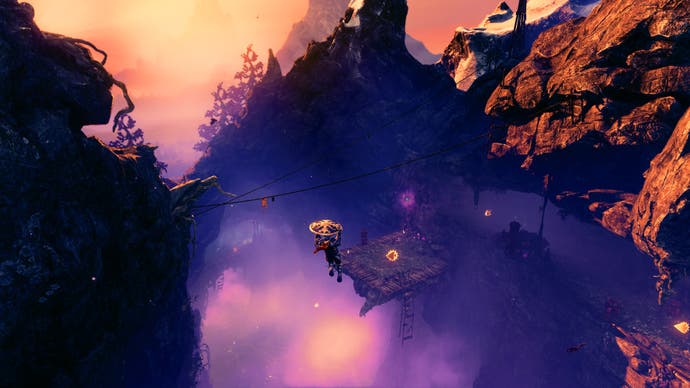
The story serves mainly to connect one puzzle-filled environment to the next, and in these areas Trine excels as ever. Three brief introductory levels familiarise us with the cast in three diverse environments, before uniting them for a handful of more substantial missions. Highlights include the Wizard's Academy itself, complete with Fantasia-style self-sweeping brooms and animated grimoires that gnash at you with paper teeth, and the following level set inside a story book, where the art takes on a cel-shaded aesthetic and giant pages literally turn as you progress. Like the two games before it, Trine 3 is a kaleidoscopic fantasy land, a dazzling display of colour and detail. The visual imagination is equalled by the puzzle design. Placing a strong emphasis on physics, most puzzles revolve around weight, momentum or balance, and you must combine the abilities of your three heroes to manipulate these things.
Here there are a couple of new elements. Most notably, Zoya can tie two objects together using the rope from her grappling hook, which lets you bind a series of platforms together so they can only move a certain distance, hold open a heavy door using a counterweight, or create ad-hoc pulley systems to drag objects about. Meanwhile, Pontius and Amadeus both possess a similar "slam" ability that can be used on springy platforms to bounce higher and higher, smash through obstacles like a wrecking ball, or shunt revolving platforms to create pathways.
Trine's approach to puzzling has proved to be something of an acquired taste. Some people love the fact that you can jerry-rig solutions by piling boxes on top of one another, or by essentially tugging on the physics system until it springs you where you need to go. Others find the lack of hard problems and solutions frustrating, believing the fact you can solve any puzzle using a box and some rope is indicative of poor design on the developer's part.
Speaking as someone whose approach to ironing is to wear clothes until the creases fall out, I like the fact that there's usually a right way and a lazy way to tackle an obstacle. Trine 3 is no different in this regard. You could figure out the exact positions to place those magical floating blocks in order to create a perfect staircase. Or you could just jump on top of one, attach Zora's grappling hook to it, and pull on it for several minutes until it eventually transports you where you need to be.
Basically, everything that was great about Trine and Trine 2 remains so here. The single-player is an enjoyably wobbly puzzle game, while playing cooperatively allows you to be extra creative or break the game even further depending on your perspective.
By now you've probably noticed I haven't mentioned the 3D aspect since the introduction. That's because the third dimension doesn't add anything significant, and actually causes multiple problems that previously didn't exist.
Although Trine 3's environments posses an extra layer of depth, it still plays very much like a 2D game. It's just that sometimes you run forward and backward rather than side to side. When Trine attempts to play with any other angles 3D offers, judging depth becomes problematic. This results in a few abrupt deaths because you couldn't determine exactly where you needed to jump. Fortunately, the platforming is forgiving enough that this is only an occasional irritation.

The only aspect of the game to be noticeably improved through the addition of 3D is combat. Now enemies can encircle you and attack from multiple directions, which makes them feel more dangerous, especially in later levels. This is great when playing as Ser Pontius with his ability to batter through crowds of opponents using his shield. Zoya gets in on the fight a little more too. She can attach her grapple to boulders and swing them around like an Olympic hammer thrower. This isn't as efficient as Pontius's pugilism, but it is more entertaining.
Nevertheless, the combat remains rather simplistic, while other aspects of the game actually function less well in 3D. Levitating boxes as Amadeus can be extremely fiddly. Zoya's bow and arrow are rendered all-but useless by a haphazard targeting system, and if there are multiple objects you can manipulate in close proximity, trying to select a specific one causes the game to spit out more X icons than Hell's Scrabble set.
The problems directly caused by the 3D are relatively minor. Indirectly, however, Trine 3 suffers much more. The length of the main story is noticeably curtailed, clocking in at around four hours. This is padded out with another two or three hours of shorter challenge maps, and a requirement to collect a certain number of floating triangles before new missions are unlocked (a terrible idea that necessitates repeat playthroughs of already-completed levels) The story feels pieced together from shards of a larger project, while the ending is extremely abrupt, skidding to a halt like a cartoon horse at what feels like just over the halfway point.
All signs point to a troubled project, the pursuit of an idea that proved far more complex than anticipated and ultimately does more harm than good. That being said, Trine 3 isn't a disaster. There's still plenty of fun to be had with its glorious environments and elastic puzzle design, and there are flashes of utter brilliance within its stumbling quest, such as that delightful storybook level.
I respect that Frozenbyte tried something different with Trine 3, and given another shot they might even be able to make it work. But I also come away from it with an unshakeable feeling that some fantasies are best left to the imagination.
